Clinical Governance Project: Pressure Ulcer Care in Hospitals
VerifiedAdded on 2022/09/21
|6
|1553
|27
Project
AI Summary
This project addresses the critical issue of pressure ulcers in a hospital setting, emphasizing the application of clinical governance principles to improve patient outcomes. The project identifies the problem of high prevalence rates, linked to factors such as immobility and limited resources, and proposes a solution that involves empowering and collaborating with family caregivers. The proposed project aims to increase family caregivers' knowledge of pressure ulcer etiology, management, and their role in the care process. It involves establishing a prevention team and a supervisory unit led by nursing leaders. The project also addresses potential barriers like limited resources and cultural factors, outlining strategies to mitigate them. The project emphasizes the importance of teamwork, technology, and continuous evaluation to assess the effectiveness of the proposed interventions. The project will be evaluated by assessing the impact of the project on the length of hospital stay, hospital acquired infections, prevalence of pressure ulcers within one month and hospital readmissions and prevalence rate after three months.
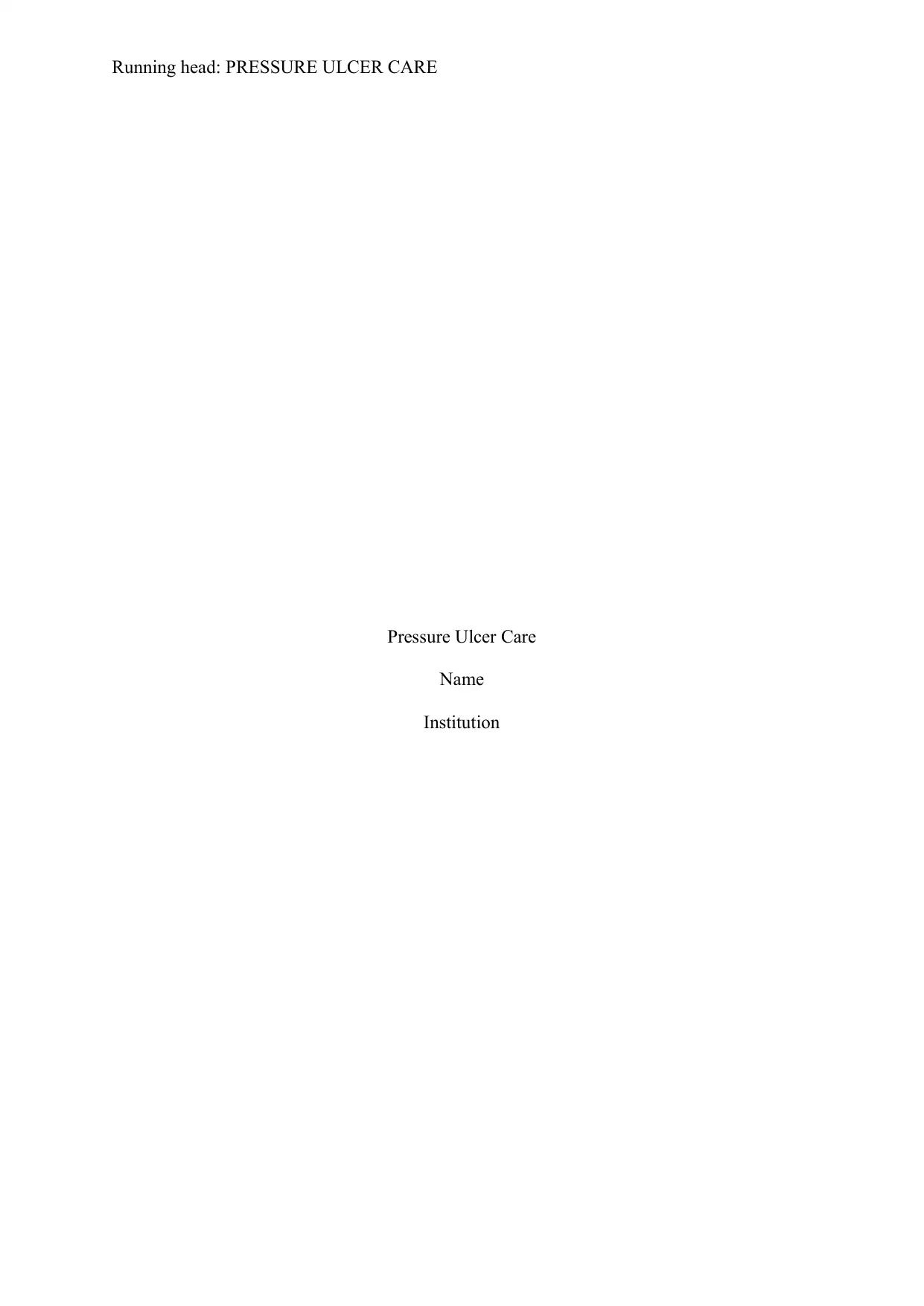
Running head: PRESSURE ULCER CARE
Pressure Ulcer Care
Name
Institution
Pressure Ulcer Care
Name
Institution
Paraphrase This Document
Need a fresh take? Get an instant paraphrase of this document with our AI Paraphraser
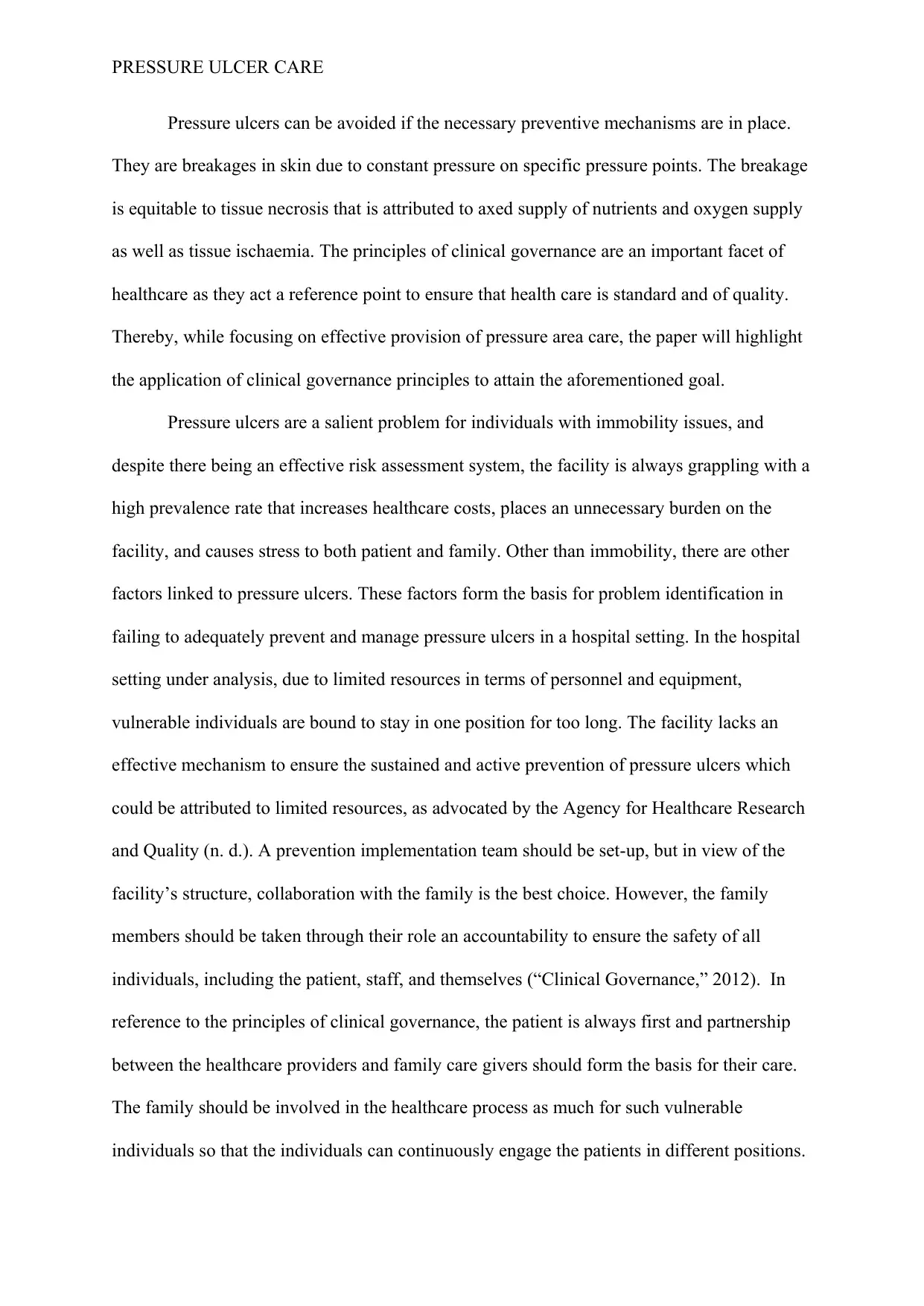
PRESSURE ULCER CARE
Pressure ulcers can be avoided if the necessary preventive mechanisms are in place.
They are breakages in skin due to constant pressure on specific pressure points. The breakage
is equitable to tissue necrosis that is attributed to axed supply of nutrients and oxygen supply
as well as tissue ischaemia. The principles of clinical governance are an important facet of
healthcare as they act a reference point to ensure that health care is standard and of quality.
Thereby, while focusing on effective provision of pressure area care, the paper will highlight
the application of clinical governance principles to attain the aforementioned goal.
Pressure ulcers are a salient problem for individuals with immobility issues, and
despite there being an effective risk assessment system, the facility is always grappling with a
high prevalence rate that increases healthcare costs, places an unnecessary burden on the
facility, and causes stress to both patient and family. Other than immobility, there are other
factors linked to pressure ulcers. These factors form the basis for problem identification in
failing to adequately prevent and manage pressure ulcers in a hospital setting. In the hospital
setting under analysis, due to limited resources in terms of personnel and equipment,
vulnerable individuals are bound to stay in one position for too long. The facility lacks an
effective mechanism to ensure the sustained and active prevention of pressure ulcers which
could be attributed to limited resources, as advocated by the Agency for Healthcare Research
and Quality (n. d.). A prevention implementation team should be set-up, but in view of the
facility’s structure, collaboration with the family is the best choice. However, the family
members should be taken through their role an accountability to ensure the safety of all
individuals, including the patient, staff, and themselves (“Clinical Governance,” 2012). In
reference to the principles of clinical governance, the patient is always first and partnership
between the healthcare providers and family care givers should form the basis for their care.
The family should be involved in the healthcare process as much for such vulnerable
individuals so that the individuals can continuously engage the patients in different positions.
Pressure ulcers can be avoided if the necessary preventive mechanisms are in place.
They are breakages in skin due to constant pressure on specific pressure points. The breakage
is equitable to tissue necrosis that is attributed to axed supply of nutrients and oxygen supply
as well as tissue ischaemia. The principles of clinical governance are an important facet of
healthcare as they act a reference point to ensure that health care is standard and of quality.
Thereby, while focusing on effective provision of pressure area care, the paper will highlight
the application of clinical governance principles to attain the aforementioned goal.
Pressure ulcers are a salient problem for individuals with immobility issues, and
despite there being an effective risk assessment system, the facility is always grappling with a
high prevalence rate that increases healthcare costs, places an unnecessary burden on the
facility, and causes stress to both patient and family. Other than immobility, there are other
factors linked to pressure ulcers. These factors form the basis for problem identification in
failing to adequately prevent and manage pressure ulcers in a hospital setting. In the hospital
setting under analysis, due to limited resources in terms of personnel and equipment,
vulnerable individuals are bound to stay in one position for too long. The facility lacks an
effective mechanism to ensure the sustained and active prevention of pressure ulcers which
could be attributed to limited resources, as advocated by the Agency for Healthcare Research
and Quality (n. d.). A prevention implementation team should be set-up, but in view of the
facility’s structure, collaboration with the family is the best choice. However, the family
members should be taken through their role an accountability to ensure the safety of all
individuals, including the patient, staff, and themselves (“Clinical Governance,” 2012). In
reference to the principles of clinical governance, the patient is always first and partnership
between the healthcare providers and family care givers should form the basis for their care.
The family should be involved in the healthcare process as much for such vulnerable
individuals so that the individuals can continuously engage the patients in different positions.
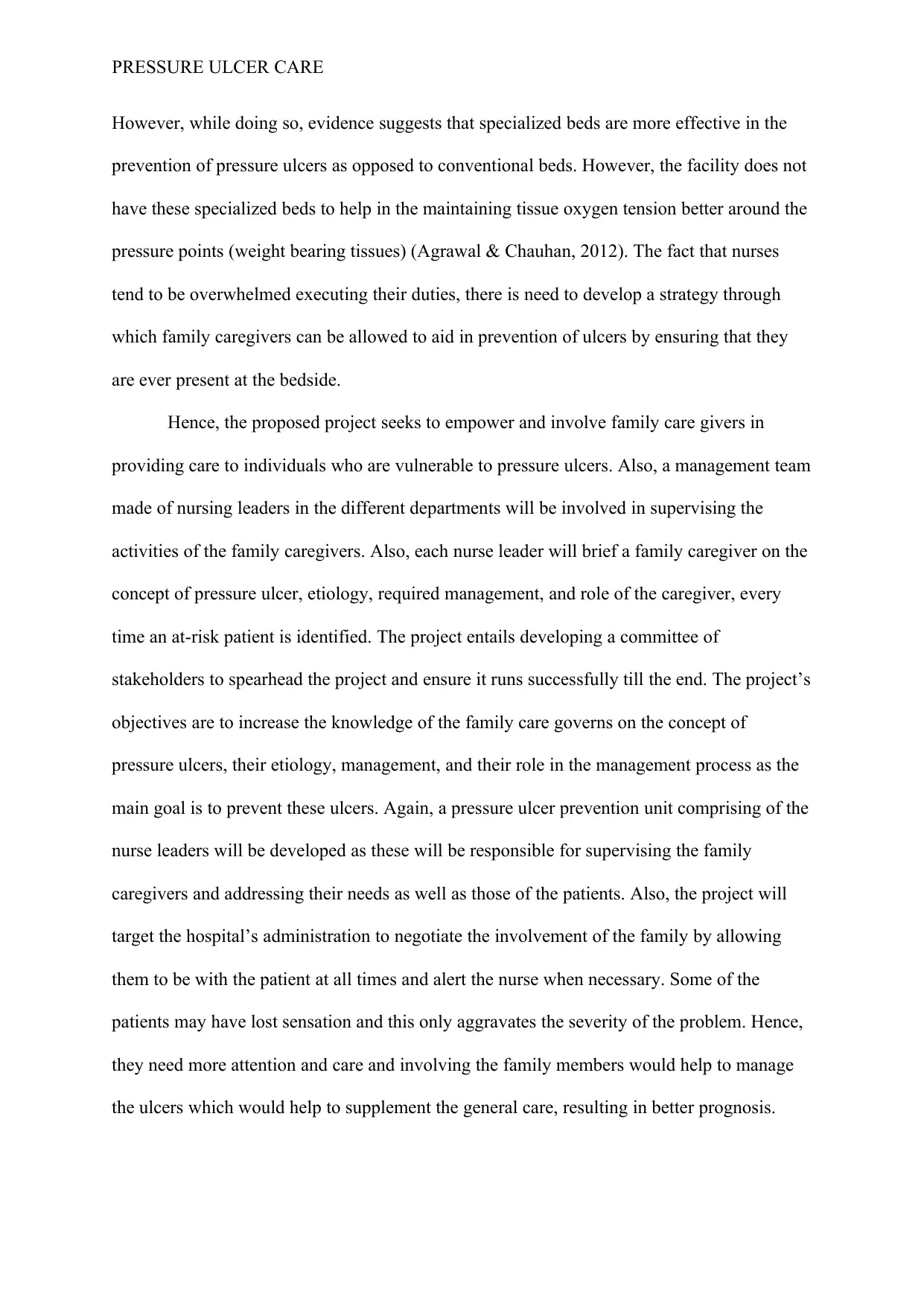
PRESSURE ULCER CARE
However, while doing so, evidence suggests that specialized beds are more effective in the
prevention of pressure ulcers as opposed to conventional beds. However, the facility does not
have these specialized beds to help in the maintaining tissue oxygen tension better around the
pressure points (weight bearing tissues) (Agrawal & Chauhan, 2012). The fact that nurses
tend to be overwhelmed executing their duties, there is need to develop a strategy through
which family caregivers can be allowed to aid in prevention of ulcers by ensuring that they
are ever present at the bedside.
Hence, the proposed project seeks to empower and involve family care givers in
providing care to individuals who are vulnerable to pressure ulcers. Also, a management team
made of nursing leaders in the different departments will be involved in supervising the
activities of the family caregivers. Also, each nurse leader will brief a family caregiver on the
concept of pressure ulcer, etiology, required management, and role of the caregiver, every
time an at-risk patient is identified. The project entails developing a committee of
stakeholders to spearhead the project and ensure it runs successfully till the end. The project’s
objectives are to increase the knowledge of the family care governs on the concept of
pressure ulcers, their etiology, management, and their role in the management process as the
main goal is to prevent these ulcers. Again, a pressure ulcer prevention unit comprising of the
nurse leaders will be developed as these will be responsible for supervising the family
caregivers and addressing their needs as well as those of the patients. Also, the project will
target the hospital’s administration to negotiate the involvement of the family by allowing
them to be with the patient at all times and alert the nurse when necessary. Some of the
patients may have lost sensation and this only aggravates the severity of the problem. Hence,
they need more attention and care and involving the family members would help to manage
the ulcers which would help to supplement the general care, resulting in better prognosis.
However, while doing so, evidence suggests that specialized beds are more effective in the
prevention of pressure ulcers as opposed to conventional beds. However, the facility does not
have these specialized beds to help in the maintaining tissue oxygen tension better around the
pressure points (weight bearing tissues) (Agrawal & Chauhan, 2012). The fact that nurses
tend to be overwhelmed executing their duties, there is need to develop a strategy through
which family caregivers can be allowed to aid in prevention of ulcers by ensuring that they
are ever present at the bedside.
Hence, the proposed project seeks to empower and involve family care givers in
providing care to individuals who are vulnerable to pressure ulcers. Also, a management team
made of nursing leaders in the different departments will be involved in supervising the
activities of the family caregivers. Also, each nurse leader will brief a family caregiver on the
concept of pressure ulcer, etiology, required management, and role of the caregiver, every
time an at-risk patient is identified. The project entails developing a committee of
stakeholders to spearhead the project and ensure it runs successfully till the end. The project’s
objectives are to increase the knowledge of the family care governs on the concept of
pressure ulcers, their etiology, management, and their role in the management process as the
main goal is to prevent these ulcers. Again, a pressure ulcer prevention unit comprising of the
nurse leaders will be developed as these will be responsible for supervising the family
caregivers and addressing their needs as well as those of the patients. Also, the project will
target the hospital’s administration to negotiate the involvement of the family by allowing
them to be with the patient at all times and alert the nurse when necessary. Some of the
patients may have lost sensation and this only aggravates the severity of the problem. Hence,
they need more attention and care and involving the family members would help to manage
the ulcers which would help to supplement the general care, resulting in better prognosis.
⊘ This is a preview!⊘
Do you want full access?
Subscribe today to unlock all pages.

Trusted by 1+ million students worldwide
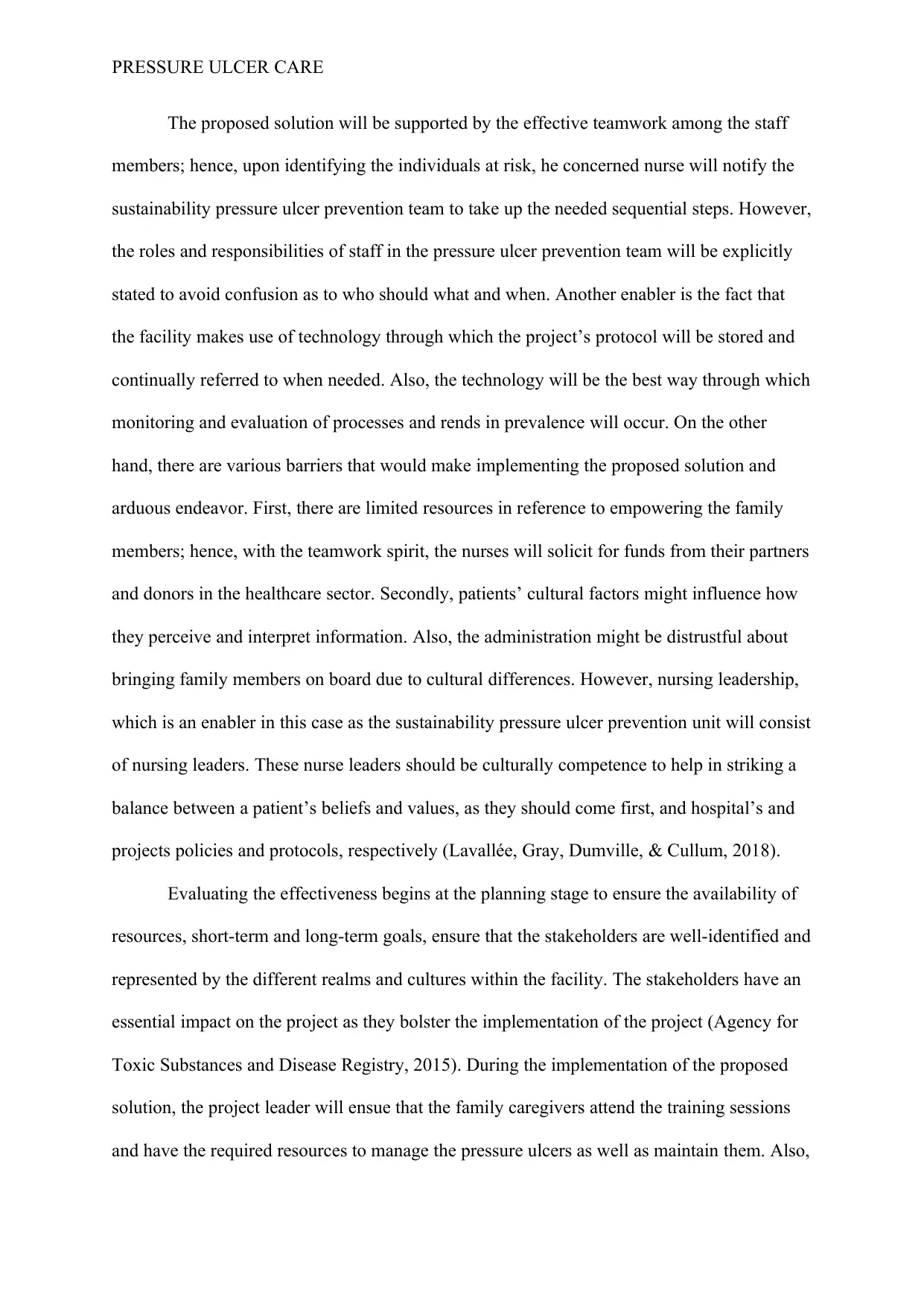
PRESSURE ULCER CARE
The proposed solution will be supported by the effective teamwork among the staff
members; hence, upon identifying the individuals at risk, he concerned nurse will notify the
sustainability pressure ulcer prevention team to take up the needed sequential steps. However,
the roles and responsibilities of staff in the pressure ulcer prevention team will be explicitly
stated to avoid confusion as to who should what and when. Another enabler is the fact that
the facility makes use of technology through which the project’s protocol will be stored and
continually referred to when needed. Also, the technology will be the best way through which
monitoring and evaluation of processes and rends in prevalence will occur. On the other
hand, there are various barriers that would make implementing the proposed solution and
arduous endeavor. First, there are limited resources in reference to empowering the family
members; hence, with the teamwork spirit, the nurses will solicit for funds from their partners
and donors in the healthcare sector. Secondly, patients’ cultural factors might influence how
they perceive and interpret information. Also, the administration might be distrustful about
bringing family members on board due to cultural differences. However, nursing leadership,
which is an enabler in this case as the sustainability pressure ulcer prevention unit will consist
of nursing leaders. These nurse leaders should be culturally competence to help in striking a
balance between a patient’s beliefs and values, as they should come first, and hospital’s and
projects policies and protocols, respectively (Lavallée, Gray, Dumville, & Cullum, 2018).
Evaluating the effectiveness begins at the planning stage to ensure the availability of
resources, short-term and long-term goals, ensure that the stakeholders are well-identified and
represented by the different realms and cultures within the facility. The stakeholders have an
essential impact on the project as they bolster the implementation of the project (Agency for
Toxic Substances and Disease Registry, 2015). During the implementation of the proposed
solution, the project leader will ensue that the family caregivers attend the training sessions
and have the required resources to manage the pressure ulcers as well as maintain them. Also,
The proposed solution will be supported by the effective teamwork among the staff
members; hence, upon identifying the individuals at risk, he concerned nurse will notify the
sustainability pressure ulcer prevention team to take up the needed sequential steps. However,
the roles and responsibilities of staff in the pressure ulcer prevention team will be explicitly
stated to avoid confusion as to who should what and when. Another enabler is the fact that
the facility makes use of technology through which the project’s protocol will be stored and
continually referred to when needed. Also, the technology will be the best way through which
monitoring and evaluation of processes and rends in prevalence will occur. On the other
hand, there are various barriers that would make implementing the proposed solution and
arduous endeavor. First, there are limited resources in reference to empowering the family
members; hence, with the teamwork spirit, the nurses will solicit for funds from their partners
and donors in the healthcare sector. Secondly, patients’ cultural factors might influence how
they perceive and interpret information. Also, the administration might be distrustful about
bringing family members on board due to cultural differences. However, nursing leadership,
which is an enabler in this case as the sustainability pressure ulcer prevention unit will consist
of nursing leaders. These nurse leaders should be culturally competence to help in striking a
balance between a patient’s beliefs and values, as they should come first, and hospital’s and
projects policies and protocols, respectively (Lavallée, Gray, Dumville, & Cullum, 2018).
Evaluating the effectiveness begins at the planning stage to ensure the availability of
resources, short-term and long-term goals, ensure that the stakeholders are well-identified and
represented by the different realms and cultures within the facility. The stakeholders have an
essential impact on the project as they bolster the implementation of the project (Agency for
Toxic Substances and Disease Registry, 2015). During the implementation of the proposed
solution, the project leader will ensue that the family caregivers attend the training sessions
and have the required resources to manage the pressure ulcers as well as maintain them. Also,
Paraphrase This Document
Need a fresh take? Get an instant paraphrase of this document with our AI Paraphraser
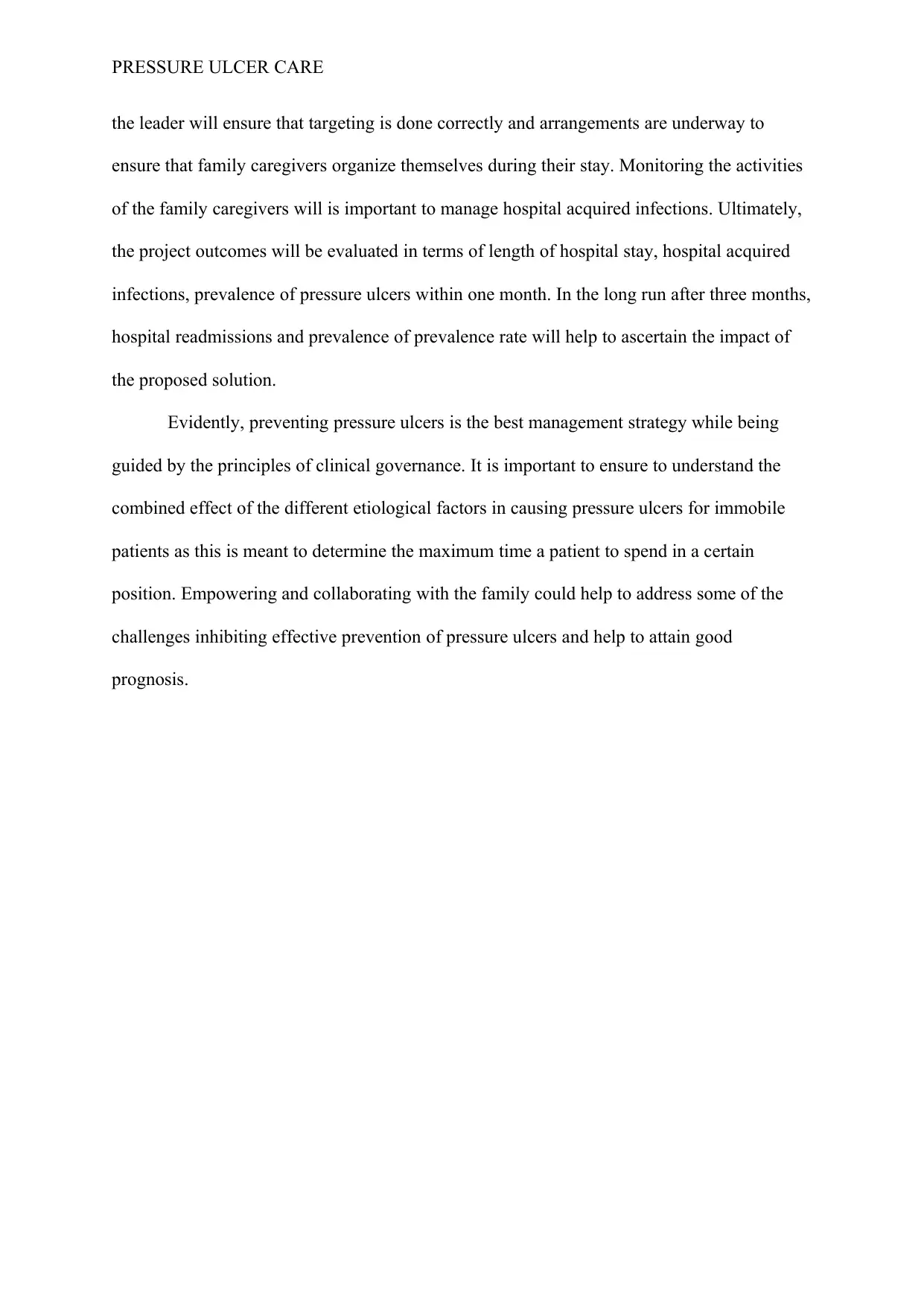
PRESSURE ULCER CARE
the leader will ensure that targeting is done correctly and arrangements are underway to
ensure that family caregivers organize themselves during their stay. Monitoring the activities
of the family caregivers will is important to manage hospital acquired infections. Ultimately,
the project outcomes will be evaluated in terms of length of hospital stay, hospital acquired
infections, prevalence of pressure ulcers within one month. In the long run after three months,
hospital readmissions and prevalence of prevalence rate will help to ascertain the impact of
the proposed solution.
Evidently, preventing pressure ulcers is the best management strategy while being
guided by the principles of clinical governance. It is important to ensure to understand the
combined effect of the different etiological factors in causing pressure ulcers for immobile
patients as this is meant to determine the maximum time a patient to spend in a certain
position. Empowering and collaborating with the family could help to address some of the
challenges inhibiting effective prevention of pressure ulcers and help to attain good
prognosis.
the leader will ensure that targeting is done correctly and arrangements are underway to
ensure that family caregivers organize themselves during their stay. Monitoring the activities
of the family caregivers will is important to manage hospital acquired infections. Ultimately,
the project outcomes will be evaluated in terms of length of hospital stay, hospital acquired
infections, prevalence of pressure ulcers within one month. In the long run after three months,
hospital readmissions and prevalence of prevalence rate will help to ascertain the impact of
the proposed solution.
Evidently, preventing pressure ulcers is the best management strategy while being
guided by the principles of clinical governance. It is important to ensure to understand the
combined effect of the different etiological factors in causing pressure ulcers for immobile
patients as this is meant to determine the maximum time a patient to spend in a certain
position. Empowering and collaborating with the family could help to address some of the
challenges inhibiting effective prevention of pressure ulcers and help to attain good
prognosis.
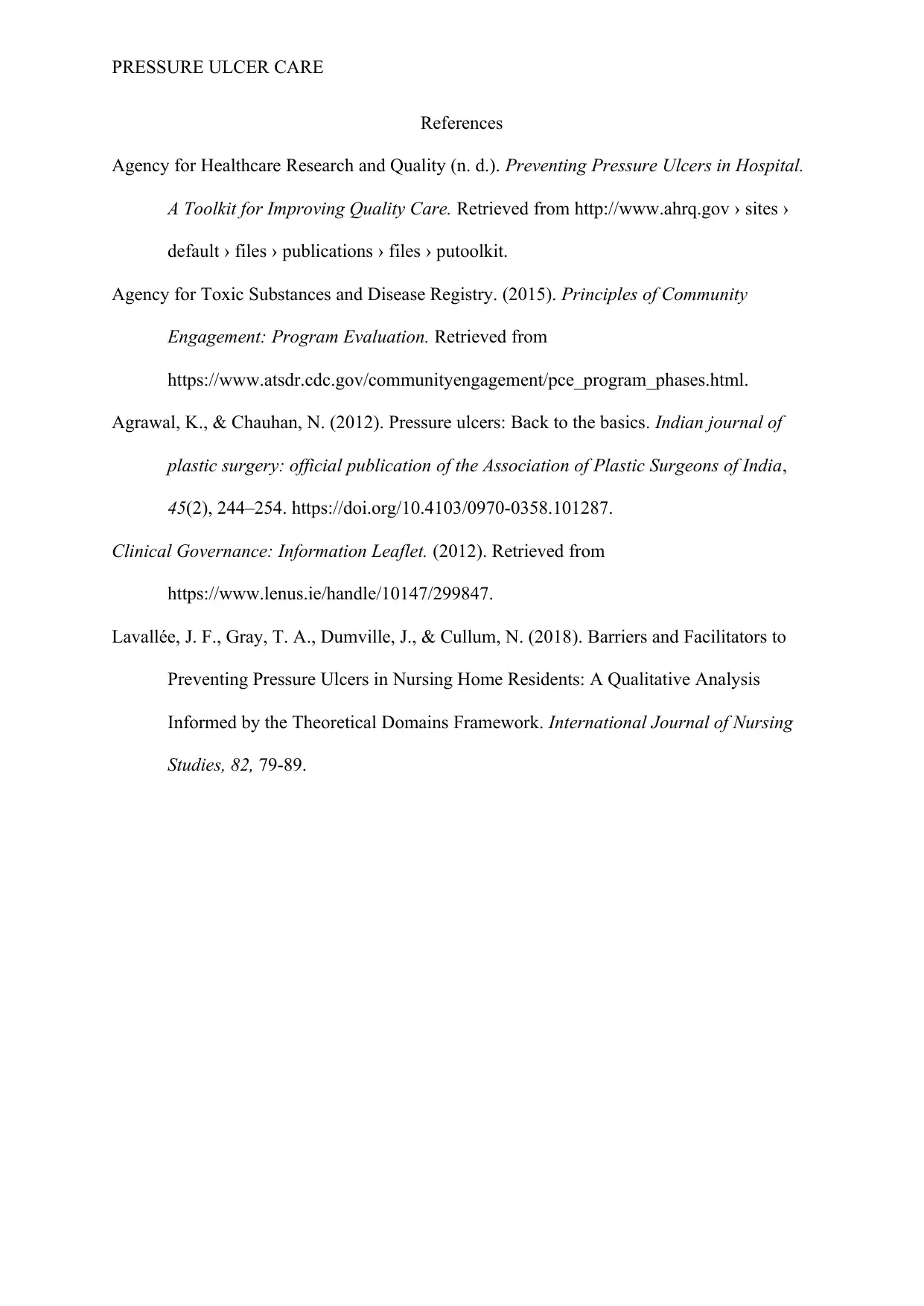
PRESSURE ULCER CARE
References
Agency for Healthcare Research and Quality (n. d.). Preventing Pressure Ulcers in Hospital.
A Toolkit for Improving Quality Care. Retrieved from http://www.ahrq.gov › sites ›
default › files › publications › files › putoolkit.
Agency for Toxic Substances and Disease Registry. (2015). Principles of Community
Engagement: Program Evaluation. Retrieved from
https://www.atsdr.cdc.gov/communityengagement/pce_program_phases.html.
Agrawal, K., & Chauhan, N. (2012). Pressure ulcers: Back to the basics. Indian journal of
plastic surgery: official publication of the Association of Plastic Surgeons of India,
45(2), 244–254. https://doi.org/10.4103/0970-0358.101287.
Clinical Governance: Information Leaflet. (2012). Retrieved from
https://www.lenus.ie/handle/10147/299847.
Lavallée, J. F., Gray, T. A., Dumville, J., & Cullum, N. (2018). Barriers and Facilitators to
Preventing Pressure Ulcers in Nursing Home Residents: A Qualitative Analysis
Informed by the Theoretical Domains Framework. International Journal of Nursing
Studies, 82, 79-89.
References
Agency for Healthcare Research and Quality (n. d.). Preventing Pressure Ulcers in Hospital.
A Toolkit for Improving Quality Care. Retrieved from http://www.ahrq.gov › sites ›
default › files › publications › files › putoolkit.
Agency for Toxic Substances and Disease Registry. (2015). Principles of Community
Engagement: Program Evaluation. Retrieved from
https://www.atsdr.cdc.gov/communityengagement/pce_program_phases.html.
Agrawal, K., & Chauhan, N. (2012). Pressure ulcers: Back to the basics. Indian journal of
plastic surgery: official publication of the Association of Plastic Surgeons of India,
45(2), 244–254. https://doi.org/10.4103/0970-0358.101287.
Clinical Governance: Information Leaflet. (2012). Retrieved from
https://www.lenus.ie/handle/10147/299847.
Lavallée, J. F., Gray, T. A., Dumville, J., & Cullum, N. (2018). Barriers and Facilitators to
Preventing Pressure Ulcers in Nursing Home Residents: A Qualitative Analysis
Informed by the Theoretical Domains Framework. International Journal of Nursing
Studies, 82, 79-89.
⊘ This is a preview!⊘
Do you want full access?
Subscribe today to unlock all pages.

Trusted by 1+ million students worldwide
1 out of 6
Related Documents
Your All-in-One AI-Powered Toolkit for Academic Success.
+13062052269
info@desklib.com
Available 24*7 on WhatsApp / Email
![[object Object]](/_next/static/media/star-bottom.7253800d.svg)
Unlock your academic potential
Copyright © 2020–2025 A2Z Services. All Rights Reserved. Developed and managed by ZUCOL.




